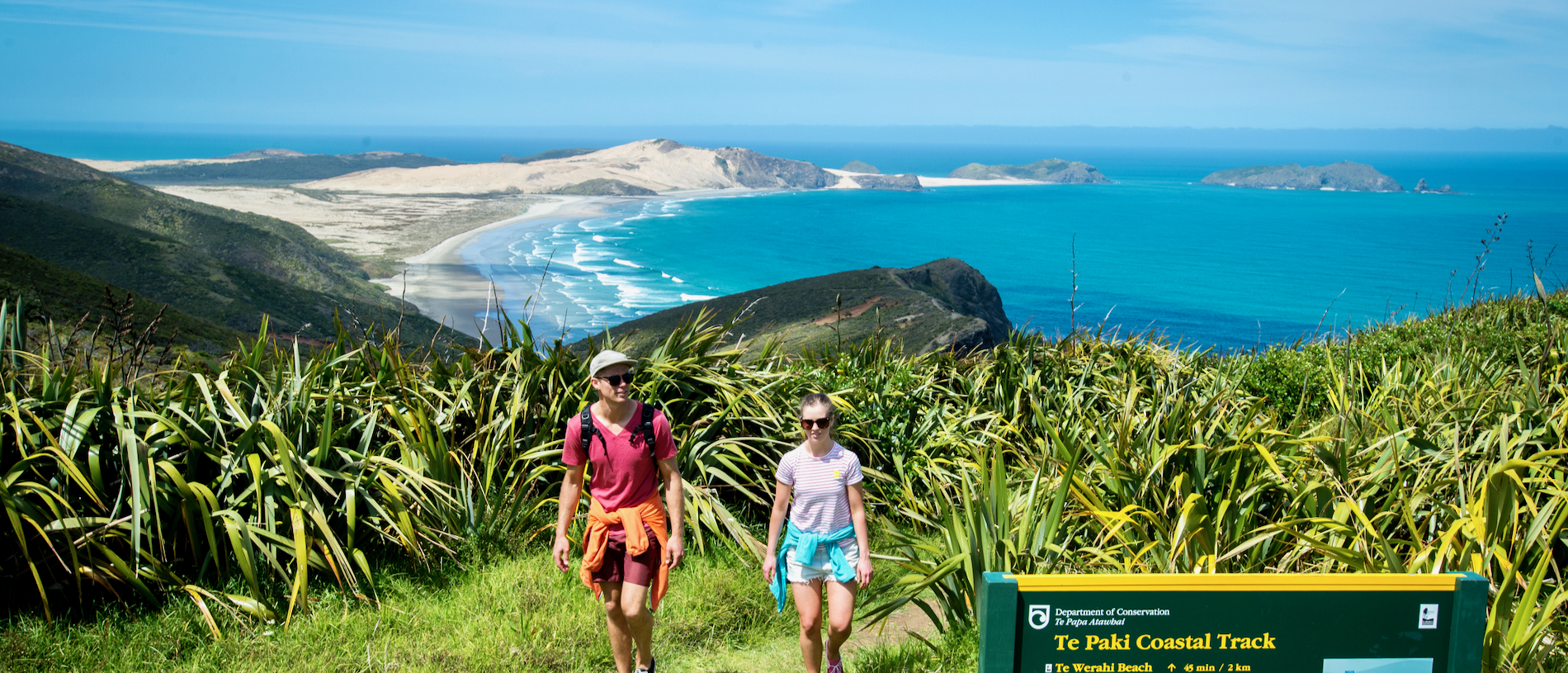
Te Paki Coastal Track: a taste of the Far North
Following the rugged coastline of Cape Rēinga, the Te Paki Coastal Track takes in some of the best beaches in the Far North Region.
While the Northland Region may be famous for its beautiful beaches, there is plenty more to discover here, too – from mind-boggling geology to art, gardens and the longest footbridge in the Southern Hemisphere. Check out these 11 great Kiwi Gems.
Rākaumangamanga Cape Brett, at the entrance to the Bay of Islands, is home to a spectacular headland, stunning views onto Motukokako Island with its famous Hole in the Rock, seals and dolphins and a historic lighthouse. Rākaumangamanga has a 1,000-year history of signalling sailors arriving in New Zealand. It was the landing point of the first seven waka that travelled from Hawaiiki to Aotearoa, whose occupants followed the dawn light reflecting off the peninsula’s crystalline rocks. The 14-metre lighthouse, constructed much later in 1906, protected seafarers from the rugged coast for over 70 years. You can get to Cape Brett either via a challenging day-long tramp from Rāwhiti or a 35-minute boat or water taxi trip from Paihia. The last of the lighthouse keepers cottages has been converted to a bookable tramping hut by the Department of Conservation and is an epic place to watch the sunrise over the ocean.
Named after their kaitiaki (guardians), the Kawiti family, the Glowworm Caves in Waiomio are cradled between rainforest and rocks. And where there be grottos, there be glowworms. Known as titiwai in Te Reo Māori, glowworms are the bioluminescent larvae of the fungus gnat. Which doesn’t sound very romantic. But the magical galaxies they create in dark spaces certainly are. At the Kawiti Glowworm Caves you can journey underground amongst stalactites (the icicle-shaped formations on a cave roof) and stalagmites (spikes that grow from the floor) on one of the guided tours that have been hosted by Kawiti descendants since the 1950s.
You won’t forget your soak in the mineral waters of Ngāwhā Springs, because every time you stroke your skin for days afterwards, you will marvel at how soft and smooth it feels. This is the real thing, whether you go to the newly-revamped Te Waiariki pools complex or the smaller, traditional The Temp next door. In both places, silky, cloudy water bubbles up from below in a range of temperatures from cool to startlingly hot. You ease down the steps into the outdoor pools and sit with your feet in the gritty mud at the bottom, feeling your muscles relax and your skin rejuvenate. You will even become inured to the pervasive smell of sulphur – although you won’t regret bringing old togs to wear.
It’s a bit of a mission to get to Wairere Boulders – a winding drive over unsealed roads – but it is well worth the effort. Scattered along a valley near the tip of the Hokianga Harbour, and leading up to a hilltop with spectacular views back down to the bush and sand dunes at the harbour mouth, is a collection of unusual and irresistibly photogenic boulders. Ejected by an eruption 2.8 million years ago, the basalt has been broken up and weathered, resulting in fascinatingly fluted rocks that, festooned with moss and epiphytes, look just gorgeous. Add in a shady native forest, a tumbling creek with a waterfall and swimming hole, exciting caves and boulders to clamber through, under and over, plus lots of helpful signs and information and you’ve got a good half-day’s enjoyment – even more, if you fancy staying at the campsite and kayaking along the harbour.
At Pōuto Point on Northland’s west coast you’ll find New Zealand’s oldest wooden lighthouse. Once a busy passage during the logging of the region’s kauri forests, the lighthouse stands at the tip of the 55km-long Pōuto Peninsula and offers commanding views over sprawling sand dunes and freshwater lakes. The peninsula is bounded by water, with the wild Tasman Sea on one side and the tidal Kaipara Harbour on the other. The entrance to the harbour is notoriously treacherous, with fast tides and strong currents and has been the site of many historic shipwrecks. Although it takes some getting to, the lighthouse is a rare beauty and worth the effort. At low tide it’s possible to drive along the beach from Pōuto for most, but not all, of the way; alternatively, you can walk 7km each way along the northern shore of the harbour mouth. If you take this option, you’ll want to pack water, snacks, sunblock and a wind-jacket – as well as a camera, of course.
Did you know that Northland has its own, bigger version of the Moeraki Boulders, but without the crowds? These vast, spherical, sandstone concretions, five million years in the making and some up to a massive three metres in diameter, are best approached within the two hours either side of low tide to avoid slippery scrambling. Allow a couple of hours for a gentle stroll between Koutu and Kaiwhare points on the south shore of the Hokianga Harbour and some boulder climbing. The further you go, the larger and more numerous the boulders are.
If you’re up for a steep, sweaty scramble up near-vertical rock, you’ll be rewarded with the best views over Northland’s Whangaroa Harbour. Duke’s Nose / Kaiaraara Rock is a 5km hike that follows a stream, passes pōhutukawa, mānuka scrub and mangroves, then climbs from behind Lane Cove Hut up 409 metres to the rocky summit of the Duke’s Nose. For the final 50m you’ll need to haul yourself up with grab railings and it’s not recommended for the faint-of-heart, or sufferers of vertigo. But for those who dare, the 360º views that take in the aquamarine harbour punctuated by ancient volcanic bluffs are quite simply breathtaking.
This gem of a garden just outside Whangārei City is deceptively bigger than you’d think, stretching over nearly an acre. With a fernery of natives across three shade houses, a small outdoor section, a room specialising in desert succulents, a Japanese garden and a heated conservatory with beautiful floral displays, make sure you set aside a decent chunk of time to enjoy Botanica Whangārei in full. Linger and soak in the tranquility of spaces filled with colourful and exotic plants. You can also opt to pack a picnic and enjoy the adjoining Cafler Park which has a lovely collection of specimen trees, a small rose garden and scented gardens.

Stretching across the upper section of Whananaki Inlet north of Matapōuri on Northland’s Tutukākā Coast you'll find the longest wooden footbridge in the Southern Hemisphere. Grab an ice cream from the Whananaki Beach Store and wander down the track alongside the school to reach the estuary. The narrow, 395-metre-long footbridge links the sleepy settlements of Whananaki South and Whananaki North and was originally constructed so kids could cross the waters to get to school. From your vantage point mid-harbour keep an eye out for stingrays which are sometimes spotted here.
Karst limestone landscapes are synonymous with underground wonderlands. At Waipu Caves, about 20 minutes inland from Waipu Village, this hollow limestone creates the spaces for a subterranean adventure. Enter the caves opposite the Whangārei District Council reserve, but make sure you come prepared. It will be wet and slippery and completely dark inside, so bring a sturdy torch and wear suitable footwear. Inside, you'll find narrow rocky tunnels that open out to soaring spaces where you can turn your torch off to marvel at the massive population of twinkling glowworms. Be prepared to get your feet wet, and don’t visit after it has rained as the caves can flood.
Hundertwasser Art Centre in Whangārei should be on everyone’s bucket list. Based on the design aesthetics of Friedensreich Hundertwasser, an Austrian artist and environmentalist who spent his last years in New Zealand, the colourful building has joyous disregard for convention: wobbly floors, mosaics everywhere, trees on the roof. Inside is a feast of Hundertwasser art, a gift shop and a café with outdoor seating and generous views of Whangārei town basin. Also based here is the Wairau Māori Art Gallery, dedicated to contemporary Māori art, featuring regularly changing exhibitions. To find the Art Centre head toward the Town Basin and look for the giant gold cupola shining, beacon-like, from its roof.